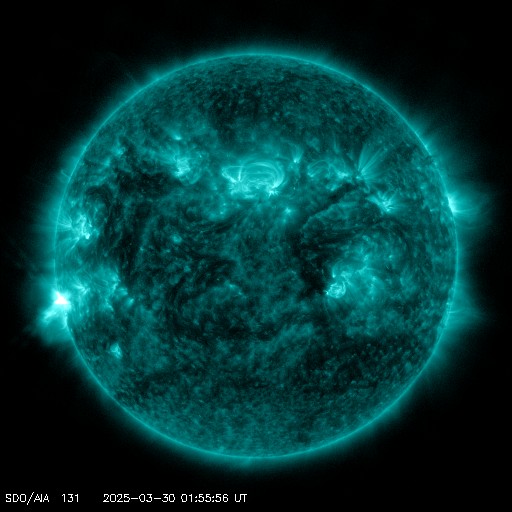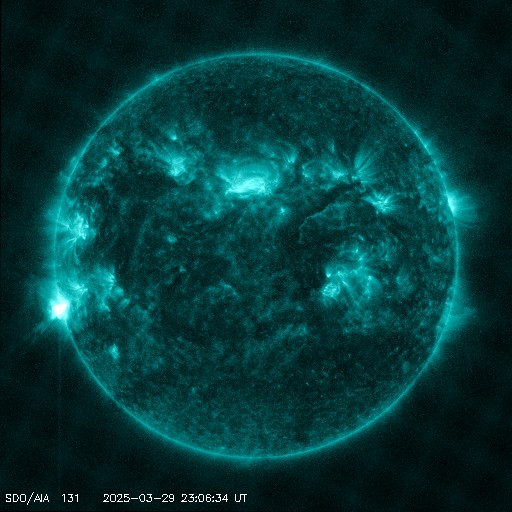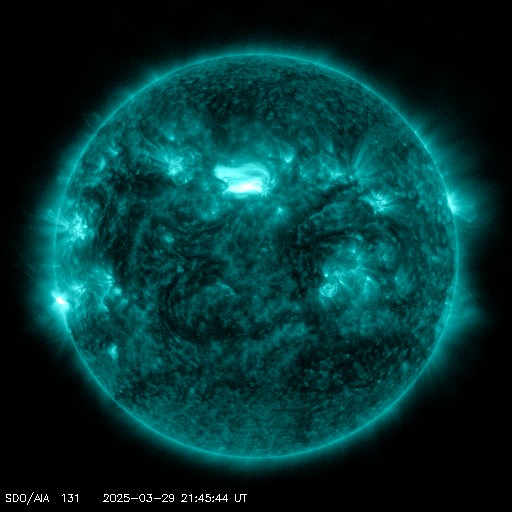Viewing archive of Wednesday, 9 March 2011
Solar activity report
Any mentioned solar flare in this report has a scaling factor applied by the Space Weather Prediction Center (SWPC). Because of the SWPC scaling factor, solar flares are reported as 42% smaller than for the science quality data. The scaling factor has been removed from our archived solar flare data to reflect the true physical units.
Report of Solar-Geophysical Activity 2011 Mar 09 2200 UTCPrepared by the NOAA © SWPC and processed by SpaceWeatherLive.com
Joint USAF/NOAA Report of Solar and Geophysical Activity
SDF Number 068 Issued at 2200Z on 09 Mar 2011IA. Analysis of Solar Active Regions and Activity from 08-2100Z to 09-2100Z
Solar activity was moderate. Two M1 x-ray flares were
observed from Region 1166 (N09W12) which was an Ekc spot group with
a Beta-Gamma-Delta magnetic classification. The area of this region
and the number of spots increased over the last 24 hours. Region
1169 (N20E18) also grew in area and number of spots over the past 24
hours, ending the period as an Esc type spot group with a Beta-Gamma
magnetic classification. The remaining regions were either small
and magnetically simple (Region 1170) or decaying (Region 1164) and
rotating off the visible disk.
IB. Solar Activity Forecast
Solar activity is expected to remain
moderate for day 1 (10 March) with a chance for M-class activity
from Region 1166 or Region 1169.
IIA. Geophysical Activity Summary 08-2100Z to 09-2100Z
The geomagnetic field was quiet. The greater than 10 MeV proton flux
remained above the 10 pfu threshold throughout the past 24 hours.
Solar wind speed measured at the STEREO-A spacecraft jumped from
approximately 650 km/s to 870 km/s near 09/0700Z. This jump was
accompanied by southward Bz to -20nT. These observations were
consistent with a shock passage from the CME that originated on
07/2012Z. The greater than 2 MeV electron flux at geosynchronous
orbit reached high levels during the period.
IIB. Geophysical Activity Forecast
The geomagnetic field is
expected to be unsettled to active, with isolated minor storm
periods possible at high latitudes on day one (10 March), and
primarily unsettled conditions on days two and three (11-12 March).
The CME from 07 March is expected to arrive mid-day on 10 March,
leading to the elevated activity.
III. Event Probabilities 10 Mar to 12 Mar
| Class M | 50% | 40% | 30% |
| Class X | 05% | 05% | 01% |
| Proton | 75% | 50% | 20% |
| PCAF | yellow | ||
IV. Penticton 10.7 cm Flux
Observed 09 Mar 143 Predicted 10 Mar-12 Mar 145/145/140 90 Day Mean 09 Mar 092
V. Geomagnetic A Indices
Observed Afr/Ap 08 Mar 004/005 Estimated Afr/Ap 09 Mar 005/008 Predicted Afr/Ap 10 Mar-12 Mar 020/022-012/018-008/008
VI. Geomagnetic Activity Probabilities 10 Mar to 12 Mar
| A. Middle Latitudes | |||
|---|---|---|---|
| Active | 25% | 25% | 25% |
| Minor storm | 20% | 15% | 01% |
| Major-severe storm | 10% | 05% | 01% |
| B. High Latitudes | |||
|---|---|---|---|
| Active | 35% | 35% | 35% |
| Minor storm | 25% | 20% | 05% |
| Major-severe storm | 15% | 10% | 05% |
All times in UTC
Current data suggests there is a slight possibility for aurora to appear at the following high latitude regions in the near future
Gillam, MB, Yellowknife, NTFairbanks, AK
Latest news
Latest forum messages
AR4046 129AR4048 20AR4043 47Incoming & Unnumbered Active Regions 1658Aurora photography hints for those of us with smartphones 51
More topicsSupport SpaceWeatherLive.com!
A lot of people come to SpaceWeatherLive to follow the Sun's activity or if there is aurora to be seen, but with more traffic comes higher server costs. Consider a donation if you enjoy SpaceWeatherLive so we can keep the website online!

Latest alerts
02:09 UTC - Solar flare
Moderate M1.54 flare from sunspot region 4048
01:42 UTC - Radio Blackout
Minor R1 radio blackout in progress (≥M1 - current: M1.24)
Saturday, 29 March 2025
23:21 UTC - Solar flare
Moderate M1.91 flare from sunspot region 4048
22:51 UTC - Radio Blackout
Minor R1 radio blackout in progress (≥M1 - current: M1.1)
21:57 UTC - Solar flare
Moderate M1.45 flare from sunspot region 4048
Space weather facts
| Last X-flare | 2025/03/28 | X1.1 |
| Last M-flare | 2025/03/30 | M1.5 |
| Last geomagnetic storm | 2025/03/27 | Kp5 (G1) |
| Spotless days | |
|---|---|
| Last spotless day | 2022/06/08 |
| Monthly mean Sunspot Number | |
|---|---|
| February 2025 | 154.6 +17.6 |
| March 2025 | 127.5 -27.1 |
| Last 30 days | 127.5 -24.7 |





